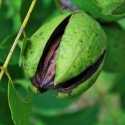
Pecan Tree Varieties
(Carya illinoinensis)
Successful Gardening. That is the point right?
Pecans are such stately shade trees and bear fruit for more than a hundred years, so choosing the right variety for your area is a pretty important decision.
Choosing the right Pecan Tree varieties starts with knowing what works together AND what works in your area.
A simple Google search and you'll find many different recommendations for "best" pecan tree combos to grow -- even if you narrow the results to just "Florida".
So what's up with all the disagreement in which two to pair together?
Getting royally confused myself, I decided to dig way deeper into the answers. I asked every pecan grower we found, WHAT he recommended and WHY he recommended it. So here's what we learned and why we selected the 2 varieties we chose to have in our nursery for resale.
Most sources agreed on one thing: the "Elliott" is the number one low chill pecan for the homeowner to grow from south Georgia to Central Florida.
ELLIOTT
Most of the nurseries seem to agree on the number one low chill pecan for the home orchard: the Elliott. It is well suited to growing conditions in zones 8 and 9: from south Georgia to Central Florida. Pecans can be grown as far south as Central Florida, with a bit of soil amending, as long as close attention is paid to being at least 3 feet above the water table.
Elliott is drought tolerant, even more so than the Desirable. It has moderate wind resistance, grows naturally with an open canopy and strong crotch angles, and therefore requires minimal tree training -- a real plus for the home owner.
Elliott trees have a strong tendency to bear alternate years. It is noted for producing well-filled nuts of good quality. Nut size is small, but quality and flavor are excellent. Cracking ability is excellent as well.
Nuts from the Elliott are thin shelled (like the old 'paper shell') and have a plump, tasty kernel. It yields about 82 nuts per pound.
In the high humidity of Florida, scab disease is the number one pest concern for pecan trees. It is caused by the fungus Fusicladosporium effusum. Elliott is one of the few cultivars that is highly resistant to scab in most locations.
The number two pest concern for pecan growers is black aphids. Elliott is amazingly resistant to this pest too.
But all pecan trees need a pollinator pecan tree to produce. So if the Elliot is number one, what is number two?
There are actually many pollinators compatible with the Elliott.
First of all, the male and female flowers of the pecan are on the same tree, but they don't bloom at the same time, so you need a second tree whose male flowers do bloom at the same time as the female flowers on the first tree, in order to get a crop.
The pollinator can be planted anywhere within a mile and still work: the wind pollinates the trees.
So pecans are classed in two groups for pollination: type 1 and type 2. The distinction has to do with what time of day the flowers open.
Amling, Cape Fear, Pawnee, Desirable, and Jackson are all type 1 pecans. Elliott, Stuart and Mohawk are all type 2 pecans.
Of the choices of type 1 pollinators, Amling seems to be the most disease resistant for extreme high humidity areas like Central FL. It is also the more tolerant of all our rain.
AMLING
Amling is a fast growing Alabama cultivar that is most resistant to the Black Aphid pests -- the second biggest plague that effects pecan trees. It is also a low chill variety that requires little maintenance and is very resistant to scab.
So while some growers will recommend the Cape Fear, or the Pawnee or the Jackson or even the Desirable to pollinate the Elliott, and they may have great success with that combo where they live, we're recommending the Amling based on what we've learned about it's pest and disease resistance for THIS part of Florida.
So that's the story: Elliott & Amling. The 2 best pecans to plant together for Gainesville south to Brooksville, Spring Hill, and even Land O Lakes, and all the way to Orlando. They are also excellent to the north of Gainesville, like Lake City & Live Oak.
Both should have ripe pecans in the month of October, just in time for that Thanksgiving pecan pie.
Plant pecans in full sun, 40-50' apart minimum. Mature pecan trees can reach as high as 70' tall and bear nuts for over 100 years.
Why the Elliott?
The original ‘Elliott’ pecan tree was a seedling in the lawn of a house in Milton,
Fla., purchased by Henry Elliot in 1912. This tree, with a trunk diameter of 0.76m, was resistant to scab and produced up to 114 kg of high quality nuts in good
years.
According to the U of GA horticulture dept., genetic analysis suggests the original tree may have resulted from nuts brought by John Hunt on his way home from the Mexican War and planted in Bagdad, Florida about 1848, only 4 km distance from Milton Fla. where the original ‘Elliott’ tree was located.
It's all about success -- getting a good crop at the end of the season. Your success.
SPRING 2019: 5g Elliott in stock Dec/Jan; please call regarding Amling;





